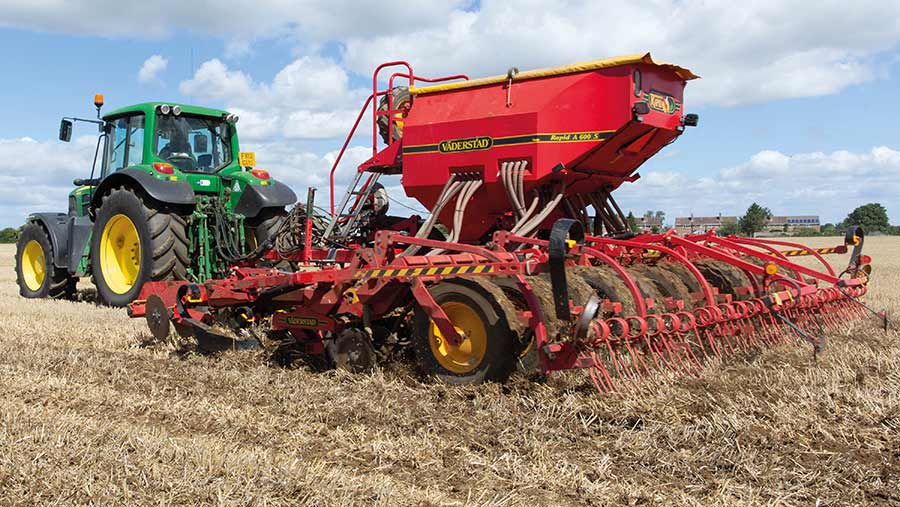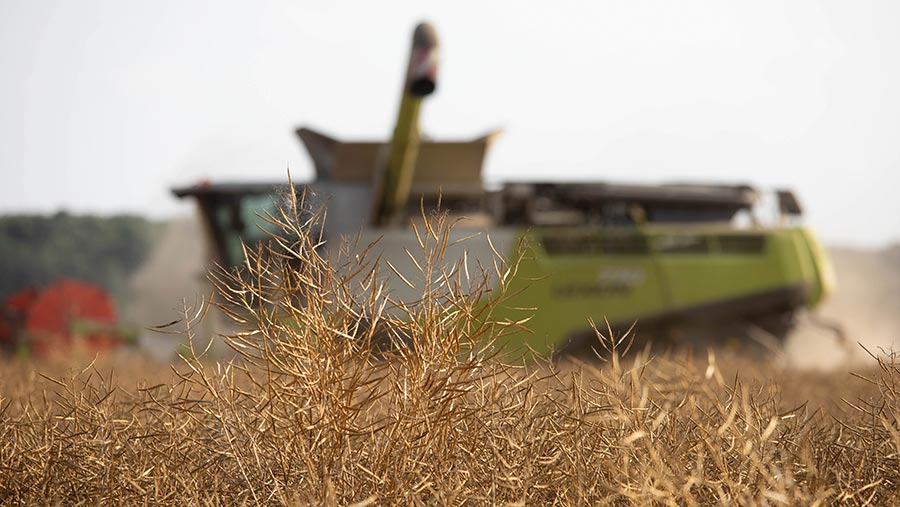A guide to which OSR varieties to grow next season
 © Gary Naylor
© Gary Naylor Twelve winter oilseed rape varieties joined the AHDB Recommended List for 2022-23, with a range of types being added as the crop’s fortunes continue to improve.
Hybrids, conventionals, specialist Clearfield varieties and one suited to clubroot-infected land were approved, while a new semi-dwarf variety was described.
For Colin Peters, break crop specialist at Niab, there are some good additions to the line-up and some welcome new genetics for phoma resistance, but there are also seven varieties that didn’t make the cut that shouldn’t be discounted.
See also: A guide to the updated autumn manure spreading rules
“There are various reasons why these varieties didn’t get recommended, but most of them have quite a bit to offer,” he says.
“It’s a good thing the AHDB publishes a list online of the ones that didn’t get added, as they are likely to be cheaper and will appeal to some.”
UK Recommendation
Turning his attention to the UK list, Mr Peters highlights Corteva’s hybrid PT303, which is the only variety to offer tolerance to sclerotinia.
“It’s important to understand that this is tolerance, rather than resistance,” he says. “It’s exactly the sort of genetic development that growers want, given the rising cost of inputs and an understandable reluctance to apply insurance sprays, especially on flowering crops.”
PT303 also tops the list for gross output, with a UK figure of 107%. It has good disease resistance, with 7 ratings for both light leaf spot and stem canker, and it scores 8s for resistance to lodging and stem stiffness.
“PT303 has a very short flowering window, which may reduce the need for fungicides during flowering anyway, even though its tolerance has a genetic basis,” says Mr Peters.
“It will certainly help growers make their minds up about whether to spray or not.”
The only downside with the breakthrough variety is that it doesn’t offer pod shatter resistance – something growers have really started to value, he adds.
Auckland is another very strong newcomer for 2022-23, which builds on the success Limagrain has developed in oilseed rape breeding.
A hybrid that also has a UK yield of 107%, it brings resistance to both turnip yellows virus (TuYV) and pod shatter.
“It seems to do well wherever it is grown,” he adds. “It’s typical of the type that Limagrain produces and will attract a following.”
Annika is a new conventional variety from Limagrain with a UK-wide recommendation and a gross output of 103%.
Bound to be of interest to growers who prefer conventionals and the ability to home-save seed, it has outperformed Aspire and is slightly better for stem canker.
“What we have to remember with most of these new oilseed rape varieties is that the Rlm7 gene used for phoma resistance won’t last forever – we know it has already been overcome in France, so additional genetics will become increasingly important,” says Mr Peters.
The two other new varieties with a UK recommendation are both Clearfield types – Matrix CL from DSV and Limagrain’s Constructor CL.
Matrix CL has a UK gross output of 99%, putting it right in contention with a comparable yield to other types.
“For growers who want herbicide-resistant varieties in their system, it’s a good choice,” he says. “It also brings an 8 for stem canker resistance.”
Constructor CL is very similar, he suggests, but with a lower gross output of 96% and a stem canker rating of 6. Like Matrix CL, it has TuYV and pod shatter resistance.
“Growers who have made the Clearfield system work seem to be sticking with it, so these two bring them additional choice and yields much more in tune with the mainstream varieties.”

© Tim Scrivener
East/West region
Four hybrid varieties were added to the Recommended List for the East/West region, with Adonis leading the pack with a gross output of 108%.
“Adonis doesn’t have the pod shatter trait, but it has very good stem canker resistance with a rating of 8,” reports Mr Peters. “This is based on the Rlm7 gene, so the same caution applies as it does to others.”
Also recommended was DSV’s hybrid Dart, which is another strong performer on 106%. Like Adonis, it offers TuYV resistance, but not pod shatter, and has 7s for light leaf spot and stem canker.
Tennyson from Elsoms has a gross output of 104% and the highest stem canker rating of 9 – which comes from a suite of genes, according to the breeder.
“We’re told that Tennyson does not rely on the Rlm7 gene alone for its exceptional resistance and that it has additional genetics,” he says. “Either way, its stem canker resistance is exceptional.”
Flemming from LSPB is the company’s second hybrid variety to include new genetics for phoma resistance in the form of the RlmS gene, which Mr Peters sees as a positive development.
“It’s good to see other breeders getting their varieties recognised and into the mix,” he says.
“We know that genetics will play an increasingly important role in protecting crops, so this diversity is very welcome and comes at the right time.”
Also on a gross output of 104%, Flemming joins its stablemate Respect on the East/West list and is expected to become a useful partner variety.

© Tim Scrivener
North region
New conventional Amarone from Limagrain has been recommended for the north region only, where it has a gross output of 105%.
Shorter than most, Amarone has good resistance to lodging and stem stiffness scores, as well as TuYV resistance. A 6 for stem canker is below that of other newcomers, although the disease is less of a concern in the North.
Clubroot resistance
New hybrid Crossfit from DSV has joined the group of varieties suitable for growing on clubroot-infected land.
Mr Peter describes it as an interesting development in this sector, as it brings both the TuYv and pod shatter resistance traits, as well as a stem canker resistance rating of 9.
“It doesn’t offer anything more on gross output, but it’s a good variety,” he says. “As with the other clubroot varieties, it should only be grown on infected land and in line with management guidelines.”
Semi-dwarf
Finally, a new semi-dwarf hybrid for the East/West region from Corteva, PX138, has been added to the list of described varieties.
With a height of 120cm and a gross output of 91%, it is slightly off the pace, but it does bring TuYV resistance to this group of three and will be of interest to growers who like this type.
UK list: Top-yielding variety Ambassador v five newcomers |
||||||
| Ambassador | PT303 | Auckland | Annika (new) | Matrix CL | Constructor CL | |
| Type | Hybrid | Hybrid | Hybrid | Conventional | Hybrid | Hybrid |
| Gross output (%) | 106 | 107 | 107 | 103 | 99 | 96 |
| Lodging | 8 | [8] | [8] | [8] | [8] | [8] |
| Pod shatter | R | – | R | – | R | R |
| Light leaf spot | 7 | 7 | 7 | 7 | 9 | 6 |
| Phoma | 7 | 7 | 7 | 6 | 8 | 6 |
| Turnip yellows virus | R | R | R | R | R | R |
|
Agronomy traits on a scale of 1-9 ,where 9 displays the trait the strongest. [] = limited data |
||||||
East and West only: Top-yielding variety Antigua v four newcomers |
|||||
| Antigua | Adonis | Dart | Tennyson | Flemming | |
| Type | Hybrid | Hybrid | Hybrid | Hybrid | Hybrid |
| Gross output (%) | 104 | 108 | 106 | 104 | 104 |
| Lodging | [8] | [8] | [8] | [8] | [8] |
| Pod shatter | R | – | – | – | – |
| Light leaf spot | 6 | 7 | 7 | 7 | 7 |
| Phoma | 7 | 8 | 7 | 9 | 8 |
| Turnip yellows virus | R | R | R | R | R |
|
Agronomy traits on a scale of 1-9, where 9 displays the trait the strongest. [] = limited data |
|||||
North-only list: Amerone and Blazen |
||
|
Amarone (new) |
Blazen | |
| Type | Conventional | Conventional |
| Gross output (%) | 105 | 101 |
| Lodging | [8] | [8] |
| Pod shatter | – | – |
| Light leaf spot | 7 | 7 |
| Phoma | 6 | 6 |
| Turnip yellows virus | R | – |
|
Agronomy traits on a scale of 1-9, where 9 displays the trait the strongest. [] = limited data |
||

